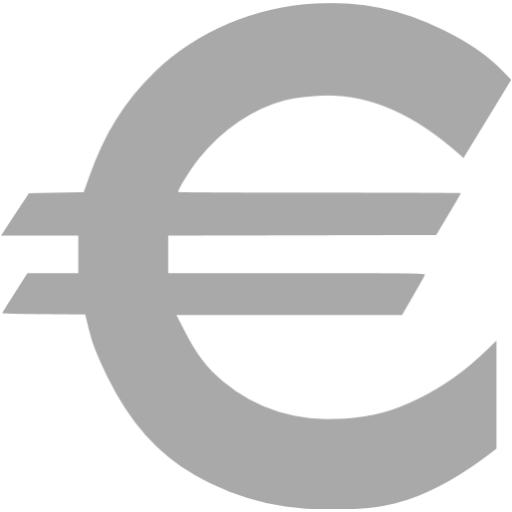What Is The Symbol Of Euro? A Comprehensive Guide
Ever wondered why the euro symbol looks so sleek and modern? The euro symbol (€) is more than just a currency sign; it's a powerful emblem of unity, stability, and economic progress in Europe. This iconic symbol has been designed with deep meaning and purpose, representing the shared vision of the European Union. In this article, we’ll dive deep into everything you need to know about the euro symbol, from its origins to its significance in today’s global economy.
The euro symbol (€) is one of the most recognized currency symbols in the world. But have you ever stopped to think about what it really represents? Beyond being a simple mark on your banknotes or receipts, the euro symbol carries a lot of weight—both literally and metaphorically. It’s not just a design; it’s a statement.
In this article, we’re going to break down the history, design, and importance of the euro symbol. Whether you’re a finance enthusiast, a traveler, or someone who’s simply curious about how currency symbols work, you’ll find something interesting here. So, let’s get started!
Read also:Andrew Wiggins The Journey Of A Rising Nba Star
Understanding the Euro Symbol: A Brief Overview
The euro symbol (€) was officially introduced in 1997 as part of the European Union’s efforts to create a single currency. It was designed to reflect the strength and unity of the eurozone countries. The symbol itself is inspired by the Greek letter epsilon (ε), which represents the cradle of European civilization, and the number "zero," symbolizing stability and precision.
But why does it matter? Well, the euro symbol isn’t just a random design. It’s a carefully crafted representation of Europe’s economic aspirations. Think of it as a logo for the eurozone—a visual identity that unites 20 countries under one currency.
Why Was the Euro Symbol Created?
The euro symbol was created to provide a unique and recognizable identity for the euro currency. Before the euro, each European country had its own currency, which made cross-border transactions complicated. The introduction of the euro symbol simplified things, making it easier for people to identify and use the currency across different nations.
- It represents the unity of the eurozone countries.
- It’s designed to be simple yet distinctive.
- It reflects the historical and cultural heritage of Europe.
History of the Euro Symbol
The journey of the euro symbol began in 1995 when the European Commission launched a competition to design the official symbol for the euro. Over 30 proposals were submitted, and the winning design was created by a Belgian graphic designer named Alain Billiet. The design was officially unveiled in December 1996, and the euro symbol was adopted as the official currency symbol for the euro.
But why was this particular design chosen? The simplicity and elegance of the symbol made it stand out. It’s easy to recognize, write, and reproduce, which is crucial for a currency symbol that needs to be used in various contexts, from banknotes to digital platforms.
Who Designed the Euro Symbol?
Alain Billiet, a graphic designer from Belgium, is credited with creating the euro symbol. His design was selected because it perfectly captured the essence of what the euro represents—unity, stability, and progress. Billiet’s inspiration came from the Greek letter epsilon and the Roman numeral "two," symbolizing the second millennium.
Read also:Uzo Aduba As Cordelia Cupp And The Stellar Cast Of The Residence Episode 101
The Design Elements of the Euro Symbol
Now, let’s take a closer look at the design elements that make the euro symbol so unique. The symbol consists of a capital "E" with two horizontal lines running through it. These lines represent stability and balance, which are key principles of the eurozone’s economic policy.
The curved lines of the "E" are reminiscent of the Greek letter epsilon, paying homage to Europe’s rich cultural heritage. Meanwhile, the straight lines symbolize strength and precision, reflecting the euro’s role as a stable and reliable currency.
What Do the Lines in the Euro Symbol Mean?
The two horizontal lines in the euro symbol are often interpreted as a symbol of stability and security. They represent the eurozone’s commitment to maintaining a strong and stable economy. Here’s a quick breakdown of what these lines signify:
- Top Line: Represents the eurozone’s focus on economic stability.
- Bottom Line: Symbolizes the currency’s reliability and trustworthiness.
How Is the Euro Symbol Used?
The euro symbol is used in a variety of contexts, from banknotes and coins to digital platforms and financial reports. It’s an integral part of the euro’s identity and is recognized worldwide. Whether you’re shopping in Paris, dining in Rome, or booking a hotel in Berlin, you’ll likely encounter the euro symbol in some form.
Interestingly, the euro symbol is also used in Unicode, making it easy to include in digital documents and websites. This ensures that the symbol remains consistent across different platforms and devices.
Where Can You Find the Euro Symbol?
You can find the euro symbol in many places, including:
- Banknotes and coins
- Financial statements and reports
- Online shopping platforms
- Mobile apps and websites
The Significance of the Euro Symbol
More than just a currency symbol, the euro symbol holds significant cultural and economic importance. It represents the shared values and aspirations of the eurozone countries. For many Europeans, the euro symbol is a source of pride and unity, symbolizing the continent’s progress toward a more integrated and prosperous future.
But the euro symbol isn’t just important for Europeans. It’s also a key player in the global economy, serving as a benchmark for other currencies and influencing international trade and finance.
Why Is the Euro Symbol Important?
The euro symbol is important for several reasons:
- It represents the eurozone’s economic strength and stability.
- It simplifies cross-border transactions within the eurozone.
- It enhances the euro’s visibility and recognition on the global stage.
Challenges and Controversies Surrounding the Euro Symbol
While the euro symbol is widely accepted and celebrated, it hasn’t been without its share of challenges and controversies. Some critics argue that the euro symbol lacks cultural diversity, as it primarily draws inspiration from Greek and Roman traditions. Others point out that the euro itself has faced economic challenges, such as the 2008 financial crisis and the Greek debt crisis.
Despite these challenges, the euro symbol remains a powerful and enduring symbol of European unity and progress. Its design and meaning continue to inspire people around the world.
Common Misconceptions About the Euro Symbol
There are a few common misconceptions about the euro symbol that are worth addressing:
- It’s Based on the Dollar Symbol: Some people believe that the euro symbol was inspired by the dollar symbol ($), but this isn’t true. The euro symbol is entirely unique and was designed with specific cultural and historical references in mind.
- It’s Only Used in Europe: While the euro symbol is most commonly used in Europe, it’s recognized and accepted worldwide, especially in financial and business contexts.
Conclusion: The Euro Symbol in a Global Context
As we’ve seen, the euro symbol (€) is much more than just a currency sign. It’s a powerful representation of Europe’s shared values, economic aspirations, and cultural heritage. From its origins in 1997 to its current status as one of the most recognized currency symbols in the world, the euro symbol has played a crucial role in shaping the global economy.
So, the next time you see the euro symbol, take a moment to appreciate its significance. Whether you’re traveling in Europe, shopping online, or reading about global finance, the euro symbol is a reminder of the power of unity and collaboration.
What are your thoughts on the euro symbol? Do you think it accurately represents the values of the eurozone? Share your thoughts in the comments below and don’t forget to share this article with your friends and family!
Table of Contents
- Understanding the Euro Symbol: A Brief Overview
- History of the Euro Symbol
- The Design Elements of the Euro Symbol
- How Is the Euro Symbol Used?
- The Significance of the Euro Symbol
- Challenges and Controversies Surrounding the Euro Symbol
- Conclusion: The Euro Symbol in a Global Context
References
1. European Central Bank. (n.d.). The euro: Europe’s currency. Retrieved from [ecb.europa.eu](https://www.ecb.europa.eu)
2. Billiet, A. (1997). The design of the euro symbol. Retrieved from [designmuseum.org](https://www.designmuseum.org)
3. Unicode Consortium. (n.d.). Unicode character ‘EURO SIGN’. Retrieved from [unicode.org](https://www.unicode.org)
Article Recommendations


